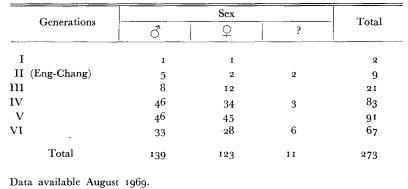Article contents
Conjoined Twins — A Genealogical Study
Published online by Cambridge University Press: 01 August 2014
Extract
Beautiful and brilliant, content and capable, skillful and successful, these and multiple other adjectives may be used to describe persons on a family tree of Eng-Chang, the original Siamese twins (Fig. 1). These men chose the State of North Carolina for homes, and are considered among its most renowned citizens. They had some of the above characteristics and their descendants shared others.
Data upon six generations of Eng-Chang families — some verified by their 1836 pamphlets, others as recent as 1969 court records in their county residence — are shown in the following table:

Fig. 2 shows second and third generations in family groups made in the summer of 1865. Nine of Eng's 11 children are shown; 2 had died young. Likewise, 9 of Chang's 10 children are seen; one was born in 1868, as certified by Edinburgh's famous Prof. James Y. Simpson (1869). Two sets of twins, not joined, are recorded in their descendants. Though some members on this family tree are difficult to certify, the data available in these six generations are by far the most comprehensive found. Chromosome and other genetic studies are being initiated and pursued in anatomy departments of American and Thai Medical Schools.
- Type
- Session 12 - Twins and Malformations
- Information
- Acta geneticae medicae et gemellologiae: twin research , Volume 19 , Issue 1-2 , April 1970 , pp. 213 - 216
- Copyright
- Copyright © The International Society for Twin Studies 1970
References
- 1
- Cited by




